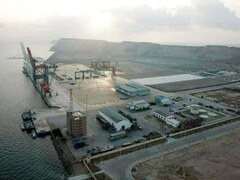The Finance Minister of the NWFP, Sirajul Haq, presented the annual budget of the province for 2004-05 in the Provincial Assembly on Friday, June 18.
The budget showed a surplus of Rs 3.62 billion over the estimated expenditure of Rs 42.65 billion. After the last several years of deficits, a surplus has been projected in the budget for the next financial year, which was prepared, according to the finance minister, in the light of the Medium Term Budgetary Framework (MTBF) agreement with the World Bank.
The annual development plan of the province was allocated at Rs 16 billion. Thus the total outlay of the budget would come to Rs 58.65 billion.
Of the total revenue receipts, federal transfer from the divisible pool of taxes to NWFP would amount to Rs 27.76 billion which would be 14 percent higher than the amount received by the province in the outgoing year. Additionally, the federal government would pay an amount of Rs 8.0 billion as share of the province in the hydel profits.
The profit was increased reportedly by the Prime Minister from the previous amount of Rs 6.0 billion which had remained unchanged for the last several years. The federal government would also transfer an amount of Rs 4.50 billion in the form of subvention to the province, besides an additional grant of Rs 1.22 billion from the GST.
The revenue receipts generated by the province are estimated at Rs 4.02 billion while royalty in respect of oil and gas would amount to Rs 357.07 million which was higher by Rs 76 million than the outgoing year's amount.
The NWFP budget was prepared with a new methodology in the light of which the allocations were divided in three categories, namely, Welfare, Administrative and Development. The welfare portion of the allocations, including the social sector projects, accounts for the largest amount or 57 percent, followed by the development programme claiming for 28 percent and administrative expenses at 15 percent of total budgeted expenditure.
The various allocations of the budget were described in terms of percentages in relation to the provincial GDP. This was undoubtedly an innovative exercise under the guidance of the World Bank.
The ADP laid greater emphasis on the completion of the on-going projects rather than going in for new ambitious projects which appeared to be a wise approach. The budget provides an amount of Rs 726 million for Tameer-e-Sarhad Programme under which the MPAs will be allocated equal amounts of funds for implementation of projects in their constituencies.
The budgetary allocations for education, health, agriculture, irrigation forests and civil works were estimated to constitute 85 percent of the total ADP which reflected a welcome emphasis on development in social sector alongside improvement in the efficiency of the productive sectors, namely, agriculture and irrigation.
The education sector accounts for the largest share amounting to Rs 12.95 billion as against Rs 10.97 billion of the revised estimates of the outgoing year. Out of the total allocation to the education sector, the largest amount or 62 percent is proposed to be spent on expansion of primary education in the province which may be seen as an appropriate policy measure. The allocation to the health sector amounts to Rs 3.30 billion which is 25 percent higher than the outgoing year's revised budget.
The programme in the health sector includes widespread improvements in the medical colleges and hospitals, including upgradation of health care centres to medium size hospitals.
The budget was described as tax free but some revisions were made in the levies like taxes on marriage halls, internet cafes, diesel and CNG filling stations.
BR100
7,874
Increased By
36.2 (0.46%)
BR30
25,599
Increased By
139.8 (0.55%)
KSE100
75,342
Increased By
411.7 (0.55%)
KSE30
24,214
Increased By
68.6 (0.28%)





















Comments
Comments are closed.